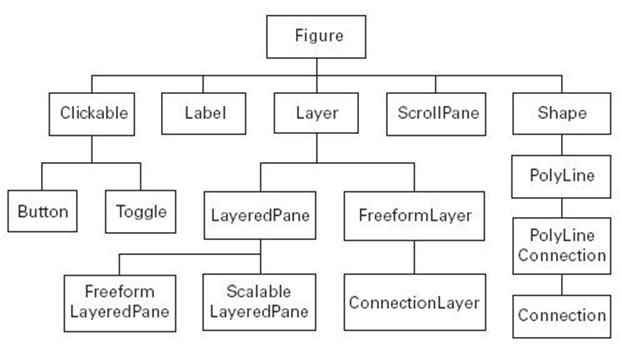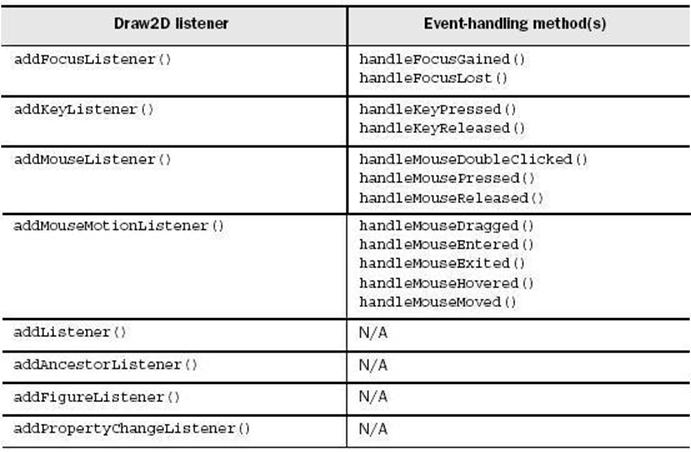GEF:使用Draw2D画流程图
在GEF(Graphical Editing Framework)介绍中已经对Draw2D进行了一些概要介绍,本篇从一个流程图的编写来学习Draw2D的是GEF的基础。
练习要求
做一个图下图所示流程图,流程图中的各个图例可以移动,每个不同类型的图例也不一样。 源码下载:flowchart-Draw2D.zip

基础概念




图例Figure
这里支持三种图例,图例从ActivityFigure继承下来。主要就是画图还有定义连接点FixedAnchor,下面先看看代码,代码都比较简单
- 开始、结束图例
1234567891011121314151617181920212223publicclassTerminatorFigureextendsActivityFigure {FixedAnchor inAnchor, outAnchor;publicTerminatorFigure() {inAnchor =newFixedAnchor(this);inAnchor.place =newPoint(1,0);targetAnchors.put("in_term", inAnchor);outAnchor =newFixedAnchor(this);outAnchor.place =newPoint(1,2);sourceAnchors.put("out_term", outAnchor);}publicvoidpaintFigure(Graphics g) {Rectangle r = bounds;g.drawArc(r.x + r.width /8, r.y, r.width /4, r.height -1,90,180);g.drawLine(r.x + r.width /4, r.y, r.x +3* r.width /4, r.y);g.drawLine(r.x + r.width /4, r.y + r.height -1,r.x +3* r.width /4, r.y + r.height -1);g.drawArc(r.x +5* r.width /8, r.y, r.width /4, r.height -1,270,180);g.drawText(message, r.x +3* r.width /8, r.y + r.height /8);}} -
分支图例
12345678910111213141516171819202122232425262728publicclassDecisionFigureextendsActivityFigure {FixedAnchor inAnchor, yesAnchor, noAnchor;publicDecisionFigure() {inAnchor =newFixedAnchor(this);inAnchor.place =newPoint(1,0);targetAnchors.put("in_dec", inAnchor);noAnchor =newFixedAnchor(this);noAnchor.place =newPoint(2,1);sourceAnchors.put("no", noAnchor);yesAnchor =newFixedAnchor(this);yesAnchor.place =newPoint(1,2);sourceAnchors.put("yes", yesAnchor);}publicvoidpaintFigure(Graphics g) {Rectangle r = bounds;PointList pl =newPointList(4);pl.addPoint(r.x + r.width /2, r.y);pl.addPoint(r.x, r.y + r.height /2);pl.addPoint(r.x + r.width /2, r.y + r.height -1);pl.addPoint(r.x + r.width, r.y + r.height /2);g.drawPolygon(pl);g.drawText(message, r.x + r.width /4+5, r.y +3* r.height /8);g.drawText("N", r.x +7* r.width /8, r.y +3* r.height /8);g.drawText("Y", r.x + r.width /2-2, r.y +3* r.height /4);}} - 流程图例
123456789101112131415161718publicclassProcessFigureextendsActivityFigure {FixedAnchor inAnchor, outAnchor;publicProcessFigure() {inAnchor =newFixedAnchor(this);inAnchor.place =newPoint(1,0);targetAnchors.put("in_proc", inAnchor);outAnchor =newFixedAnchor(this);outAnchor.place =newPoint(1,2);sourceAnchors.put("out_proc", outAnchor);}publicvoidpaintFigure(Graphics g) {Rectangle r = bounds;g.drawText(message, r.x + r.width /4, r.y + r.height /4);g.drawRectangle(r.x, r.y, r.width -1, r.height -1);}} - FixedAnchor:连接画线时会根据place来调用getLocation确定连接终点的位置
123456789101112131415161718publicclassFixedAnchorextendsAbstractConnectionAnchor{Point place;publicFixedAnchor(IFigure owner){super(owner);}publicPoint getLocation(Point loc){Rectangle r = getOwner().getBounds();intx = r.x + place.x * r.width/2;inty = r.y + place.y * r.height/2;Point p =newPrecisionPoint(x,y);getOwner().translateToAbsolute(p);returnp;}} - ActivityFigure:主要处理连接点的代码
123456789101112131415161718192021222324252627282930313233343536373839404142434445464748495051525354555657585960616263646566676869707172737475767778798081828384858687888990919293949596979899abstractpublicclassActivityFigureextendsFigure {Rectangle r =newRectangle();Hashtable targetAnchors =newHashtable();Hashtable sourceAnchors =newHashtable();String message =newString();publicvoidsetName(String msg) {message = msg;repaint();}publicConnectionAnchor ConnectionAnchorAt(Point p) {ConnectionAnchor closest =null;longmin = Long.MAX_VALUE;Hashtable conn = getSourceConnectionAnchors();conn.putAll(getTargetConnectionAnchors());Enumeration e = conn.elements();while(e.hasMoreElements()) {ConnectionAnchor c = (ConnectionAnchor) e.nextElement();Point p2 = c.getLocation(null);longd = p.getDistance2(p2);if(d < min) {min = d;closest = c;}}returnclosest;}publicConnectionAnchor getSourceConnectionAnchor(String name) {return(ConnectionAnchor) sourceAnchors.get(name);}publicConnectionAnchor getTargetConnectionAnchor(String name) {return(ConnectionAnchor) targetAnchors.get(name);}publicString getSourceAnchorName(ConnectionAnchor c) {Enumeration<String> keys = sourceAnchors.keys();String name;while(keys.hasMoreElements()) {name = (String) keys.nextElement();if(sourceAnchors.get(name).equals(c))returnname;}returnnull;}publicString getTargetAnchorName(ConnectionAnchor c) {Enumeration<String> keys = targetAnchors.keys();String name =null;while(keys.hasMoreElements()) {name = (String) keys.nextElement();if(targetAnchors.get(name).equals(c))returnname;}returnnull;}publicConnectionAnchor getSourceConnectionAnchorAt(Point p) {ConnectionAnchor closest =null;longmin = Long.MAX_VALUE;Enumeration e = getSourceConnectionAnchors().elements();while(e.hasMoreElements()) {ConnectionAnchor c = (ConnectionAnchor) e.nextElement();Point p2 = c.getLocation(null);longd = p.getDistance2(p2);if(d < min) {min = d;closest = c;}}returnclosest;}publicHashtable getSourceConnectionAnchors() {returnsourceAnchors;}publicConnectionAnchor getTargetConnectionAnchorAt(Point p) {ConnectionAnchor closest =null;longmin = Long.MAX_VALUE;Enumeration e = getTargetConnectionAnchors().elements();while(e.hasMoreElements()) {ConnectionAnchor c = (ConnectionAnchor) e.nextElement();Point p2 = c.getLocation(null);longd = p.getDistance2(p2);if(d < min) {min = d;closest = c;}}returnclosest;}publicHashtable getTargetConnectionAnchors() {returntargetAnchors;}}
连接点PathFigure
连接点从PolylineConnection继承下来,在构造函数中设置目标对象连接点的装饰类,也就是示例中的三角形(PolylineDecoration),以及设定连接线路由样式,这里设置为ManhattanConnectionRouter
1 2 3 4 5 6 7 8 9 | public class PathFigure extends PolylineConnection { public PathFigure() { //setSourceDecoration(new PolygonDecoration()); setTargetDecoration(new PolylineDecoration()); //setConnectionRouter(new BendpointConnectionRouter()); setConnectionRouter(new ManhattanConnectionRouter()); }} |
监听移动事件
1 2 3 4 5 6 7 8 9 10 11 12 13 14 15 16 17 18 19 20 21 22 23 24 25 26 27 28 29 | public class Dnd extends MouseMotionListener.Stub implements MouseListener { public Dnd(IFigure figure) { figure.addMouseMotionListener(this); figure.addMouseListener(this); } Point start; public void mouseReleased(MouseEvent e) { } public void mouseClicked(MouseEvent e) { } public void mouseDoubleClicked(MouseEvent e) { } public void mousePressed(MouseEvent e) { start = e.getLocation(); } public void mouseDragged(MouseEvent e) { Point p = e.getLocation(); Dimension d = p.getDifference(start); start = p; Figure f = ((Figure) e.getSource()); f.setBounds(f.getBounds().getTranslated(d.width, d.height)); }} |
Flowchart
Flowchart是主程序代码,生成最上图所示的所有图例、连接,并把连接于连接点关联起来,并加入监听移动事件对象
1 2 3 4 5 6 7 8 9 10 11 12 13 14 15 16 17 18 19 20 21 22 23 24 25 26 27 28 29 30 31 32 33 34 35 36 37 38 39 40 41 42 43 44 45 46 47 48 49 50 51 52 53 54 55 | public class Flowchart { public static void main(String args[]) { Shell shell = new Shell(); shell.setSize(300, 400); shell.open(); shell.setText("Flowchart"); LightweightSystem lws = new LightweightSystem(shell); ChartFigure flowchart = new ChartFigure(); lws.setEventDispatcher(new SWTEventDispatcherX(1800000L)); lws.setContents(flowchart); TerminatorFigure start = new TerminatorFigure(); start.setName("Start"); start.setToolTip(new Label("起点")); start.setBounds(new Rectangle(40, 20, 80, 20)); DecisionFigure dec = new DecisionFigure(); dec.setName("Should I?"); dec.setBounds(new Rectangle(30, 60, 100, 60)); ProcessFigure proc = new ProcessFigure(); proc.setName("Do it!"); proc.setToolTip(new Button("do it")); proc.setBounds(new Rectangle(40, 140, 80, 40)); TerminatorFigure stop = new TerminatorFigure(); stop.setName("End"); stop.setBounds(new Rectangle(140, 300, 80, 20)); PathFigure path1 = new PathFigure(); path1.setSourceAnchor(start.outAnchor); path1.setTargetAnchor(dec.inAnchor); PathFigure path2 = new PathFigure(); path2.setSourceAnchor(dec.yesAnchor); path2.setTargetAnchor(proc.inAnchor); PathFigure path3 = new PathFigure(); path3.setSourceAnchor(dec.noAnchor); path3.setTargetAnchor(stop.inAnchor); PathFigure path4 = new PathFigure(); path4.setSourceAnchor(proc.outAnchor); path4.setTargetAnchor(stop.inAnchor); flowchart.add(start); flowchart.add(dec); flowchart.add(proc); flowchart.add(stop); flowchart.add(path1); flowchart.add(path2); flowchart.add(path3); flowchart.add(path4); new Dnd(start); new Dnd(proc); new Dnd(dec); new Dnd(stop); Display display = Display.getDefault(); while (!shell.isDisposed()) { if (!display.readAndDispatch()) display.sleep(); } }} |
参考:Draw2D教程
推荐:你可能需要的在线电子书
欢迎转载,转载请注明:转载自周金根 [ http://zhoujg.cnblogs.com/ ]















【推荐】编程新体验,更懂你的AI,立即体验豆包MarsCode编程助手
【推荐】凌霞软件回馈社区,博客园 & 1Panel & Halo 联合会员上线
【推荐】抖音旗下AI助手豆包,你的智能百科全书,全免费不限次数
【推荐】博客园社区专享云产品让利特惠,阿里云新客6.5折上折
【推荐】轻量又高性能的 SSH 工具 IShell:AI 加持,快人一步
· [.NET]调用本地 Deepseek 模型
· 一个费力不讨好的项目,让我损失了近一半的绩效!
· .NET Core 托管堆内存泄露/CPU异常的常见思路
· PostgreSQL 和 SQL Server 在统计信息维护中的关键差异
· C++代码改造为UTF-8编码问题的总结
· CSnakes vs Python.NET:高效嵌入与灵活互通的跨语言方案对比
· 【.NET】调用本地 Deepseek 模型
· Plotly.NET 一个为 .NET 打造的强大开源交互式图表库
· 上周热点回顾(2.17-2.23)
· 如何使用 Uni-app 实现视频聊天(源码,支持安卓、iOS)
2009-11-23 WPF - 图形设计器(Diagram Designer)
2009-11-23 信息系统开发平台OpenExpressApp -如何部署OEA应用